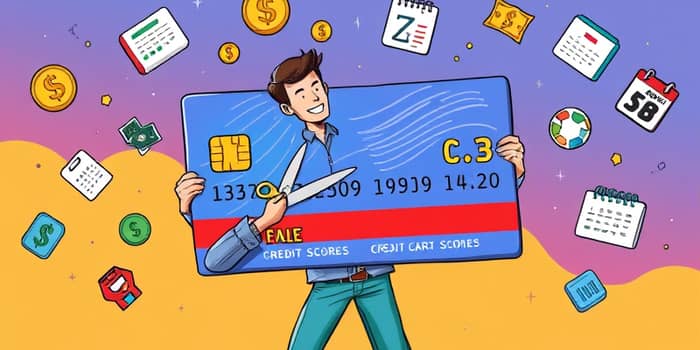Making the decision to cancel or switch your credit card can feel daunting, but with the right approach, you can navigate the process smoothly and protect your financial health.
Why You Might Consider Cancelling or Switching
Credit cards are powerful financial tools, but they’re not one-size-fits-all. You might find yourself questioning whether your current card still aligns with your needs, especially if an annual fee outweighs the benefits you receive.
Beyond fees, managing multiple accounts can become overwhelming. If you frequently miss payments or worry about overspending, closing or switching your card could help you maintain better spending control.
Key Steps to Cancel Your Credit Card
When you’re ready to cancel, following a systematic approach ensures you won’t overlook critical details. Taking the time to prepare will minimize surprises and safeguard your credit profile.
- Pay off your remaining balance in full to avoid ongoing interest charges.
- Cancel recurring payments and subscriptions linked to the card before you close the account.
- Redeem your rewards for statement credits, cash back, or gift cards prior to cancellation.
- Contact your issuer via phone, website, or secure message center to initiate the closure request.
- Get written confirmation of the account closure for your records.
- Check your credit report in the weeks following closure to confirm the account status.
- Physically destroy the card to prevent fraud and identity theft.
By working through each step carefully, you’ll ensure a clean break from your old account and avoid unexpected charges or lapses in service.
Alternative Option: Requesting a Product Change
If you value your existing history with a bank, you may choose to request a product change instead of a full cancellation. A product change allows you to maintain your credit limit and account age while accessing new benefits.
For example, you could move from a card with a high annual fee to one without fees or switch to a co-branded rewards card that better suits your spending habits. Consulting with your issuer’s customer service team can help identify the right option.
Understanding the Impact on Your Credit Score
Closing a credit card account can affect your score in several ways. The most immediate effect is on your credit utilization ratio, which compares your outstanding balances to your total available credit. A lower available credit limit may increase your utilization and temporarily dip your score.
Another consideration is the length of credit history. If the card you’re closing is one of your oldest, your average account age may decrease, which could have a negative impact, especially if you don’t have other long-standing accounts.
Maintaining a healthy mix of credit types, including installment loans and revolving accounts, also factors into your overall credit profile. Evaluate these elements before deciding whether cancellation is worth the potential trade-off.
Dealing with Retention Offers
As you initiate the cancellation process, issuers often present counter-offers to keep your account open. These may include fee waivers, promotional interest rates, or bonus rewards. While tempting, consider whether these incentives align with your long-term goals.
If you’re committed to closing your account, prepare a polite but firm statement declining any offers and reiterate your intention to close. This helps avoid further calls or emails that could disrupt your plans.
The Timeline and Aftercare
After you cancel or switch products, it can take time for your request to reflect across all systems. Staying proactive during this period will give you peace of mind.
Your next step is to review your credit reports regularly—at least one free report each year—and dispute any inaccuracies. This diligence will help you maintain control over your financial narrative.
Switching to a New Provider
If you’re seeking better terms or enhanced rewards, switching providers can be a strategic move. Begin by researching cards that offer the features most important to you, such as no annual fee, travel perks, or introductory rates.
- Apply and secure approval for your new card before cancelling the old one.
- Transfer any recurring payments and link your billing information to the new account.
- Move over any auto-payments, such as utilities, subscriptions, or memberships.
- Redeem outstanding rewards on your old card before you close it.
- Complete the cancellation steps outlined above to finalize the transition.
By lining up your new account first, you avoid gaps in payment processing and preserve your credit availability.
Final Recommendations
Whether you decide to cancel outright or switch cards, preparing thoroughly will ensure you protect your credit health and maximize benefits. Keep these takeaways in mind:
Assess your spending habits, review fee structures, and choose the product that supports your financial goals. Remember, credit cards are tools that should work for you, not the other way around.
Finally, stay organized by keeping detailed records of your cancellation requests, written confirmations, and credit report checks. With a clear plan and careful execution, you can manage your credit cards confidently and effectively.
References
- https://www.creditkarma.com/credit-cards/i/how-to-cancel-credit-card
- https://www.investopedia.com/how-to-cancel-a-credit-card-4590033
- https://www.consumerfinance.gov/ask-cfpb/i-want-to-close-my-credit-card-account-what-should-i-do-en-84/
- https://www.capitalone.com/learn-grow/money-management/how-to-cancel-a-credit-card/
- https://thepointsguy.com/credit-cards/how-cancel-credit-card/
- https://www.experian.com/blogs/ask-experian/is-it-better-to-cancel-unused-credit-cards-or-keep-them/
- https://www.lendingclub.com/resource-center/personal-finance/how-to-cancel-a-credit-card-without-hurting-your-credit-score
- https://www.chase.com/personal/credit-cards/education/basics/how-to-cancel-a-credit-card










